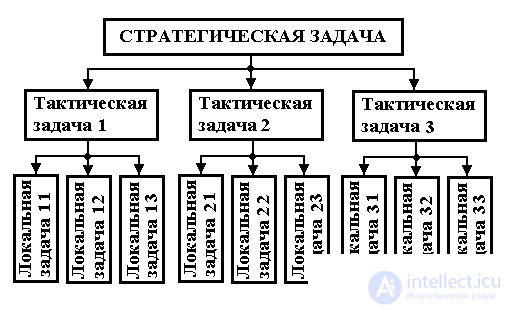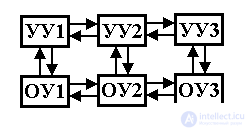Lecture

A complex system (SS) is a system that includes a large number of interacting elements (subsystems) and provides a solution to a rather complex (complex) task. Such systems include information networks (telephone, local, Internet), transport networks, production processes, control systems of complex (multichannel, nonlinear, indefinite) dynamic objects (for example, air and space objects).
For complex control systems , the following features are characteristic:


Fig. 1.17
It is customary to single out strategic tasks with different levels of hierarchy, as well as tactical and local control tasks.
Remark 1.7. The main thing in terms of a complex task and a complex system is their structurization, i.e. possibility of splitting into components of less complexity. The choice of such components is ambiguous, and the terminology used in this process (for example, the names of hierarchy levels) is rather conventional.
The strategic management tasks include technological tasks: the manufacture of a chemical product, a product, a part, flight control, etc., i.e. the task of maintaining a certain sequence of actions of a complex (complex) object, in the course of which a certain technological problem is solved.
A tactical task is an element of a common strategic task that establishes requirements for the behavior of each elementary object of a complex system and / or the implementation of an elementary regime. Tactical control tasks include the task of controlling the movement of the aircraft’s steering gear, controlling the machining of a part on a machine, controlling the cycle of a chemical process.
Example 1.4. The tactical task of managing the machining of a part on a machine is made in the form of a technological program . The latter consists of "frames", each of which contains coded information about the type of operation being performed and its parameters (speed of movement, coordinates of node points, type and parameters of movement trajectories, etc.) task to perform local management tasks.

A local task is the task of changing or maintaining the state of an elementary object (see the definition of the term management ). The local ones include, in particular, the tasks of stabilizing the position or speed, the tasks of tracking an external object or the control signal y * ( t ).
Thus, the concept of a complex task provides for the possibility of dividing the overall strategic task into a number of more
simple problems solved sequentially or in parallel.  Hence the following principles of managing a complex system:
Hence the following principles of managing a complex system:

Multimode control can be carried out:
Fig. 1.18 illustrates the hardware and software implementation of multi-mode control.

Fig. 1.18 Hardware (a) and software (b) implementation of multi-mode control
Example 1.5 . (Transport system.)
The system is designed to organize the automatic transportation of items (parts, products and tools) on the technological (production, trade, etc.) site.

Fig. 1.19. Transportation system
The scheme of the system is shown in Fig. 1.19, where TT1 - TT2 - transport trolleys, C1 - C6 - working stations.
The strategic objective of such a system is the transport support of the technological process, i.e. transportation of items between workstations in accordance with the current needs of the site. The task is divided into sequential and parallel solvable tactical tasks — transporting cargo with one TT wagon i> from station Ci to station Cj. Local tasks arising from trolley movement are tasks of type
Comments
To leave a comment
Mathematical foundations of the theory of automatic control
Terms: Mathematical foundations of the theory of automatic control